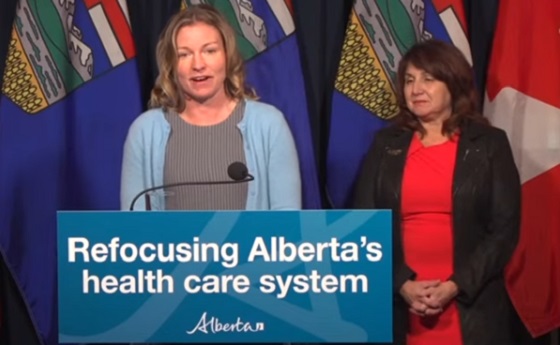Alberta
Sun setting on AHS as first of four provincial health agencies, Primary Care Alberta set to launch

Primary Care Alberta, the new provincial health agency overseeing and coordinating the delivery of primary health care services, will become operational later this fall.
Alberta’s government is taking action to refocus the health care system so that every Albertan has access to a primary health care provider and timely, high-quality primary health care, no matter where they live.
Alberta’s new primary care provincial health agency, Primary Care Alberta, will create a modern, more responsive and unified health care system that prioritizes patients, empowers front-line health care professionals and helps reduce pressures on the entire health system.
The immediate priority of Primary Care Alberta is to ensure every Albertan has access to high-quality primary care services in all areas of the province, so all Albertans and their families are supported in their day-to-day health needs through every stage of life. The new primary care agency will focus on supporting integrated teams of family physicians, nurse practitioners and pharmacists to provide patients with the best care possible.
“Standing up Primary Care Alberta is an important milestone in refocusing the health care system to put patients first and give our front-line experts the support they need to ensure Albertans are receiving the care they deserve.”
Kim Simmonds, the current assistant deputy minister of strategic planning and performance at Alberta Health, will be appointed as chief executive officer of Primary Care Alberta. Simmonds brings a wealth of public and private sector experience to the role and has extensive experience working with stakeholders across the health care system. She has experience working with clinicians and understands the need for data and evidence-based decision-making when it comes to delivering primary care services to Albertans, no matter where they live.
“If primary care is to be the foundation on which the entire health system stands, every Albertan must have an ongoing connection and trusting relationship with a family doctor or health care team. They must belong to a health home where they are known and where they don’t have to tell their health story over and over again. There is much work to do in Alberta to achieve these goals, and I’m eager to get going to help make it happen.”
Modernizing Alberta’s Primary Care System (MAPS)
In 2022, the Modernizing Alberta’s Primary Care System (MAPS) initiative was launched to recommend ways to strengthen Alberta’s primary health care system. Alberta’s government undertook extensive engagement with its primary care providers and stakeholders to develop a guide to strengthen primary health care in Alberta. The MAPS final report recommended creating a single governance structure that supports an integrated team of health care professionals with data sharing within and across sectors.
Improving the coordination and delivery of primary care was also something Alberta’s government heard during provincewide engagement sessions held earlier this year as part of efforts to engage with Albertans and health care professionals on how to refocus the health care system. This made-in-Alberta solution is the first of its kind to be established in a provincial health care system. The agency is a dedicated organization to support governance, oversight, delivery, operation and coordination, a significant step being taken to improve the quality of health care delivery in the province.
Quick facts
- The Provincial Health Agencies Act enables the transition from one regional health authority, Alberta Health Services (AHS), to an integrated system of four sector-based provincial health agencies: primary care, acute care, continuing care, and mental health and addiction.
- The agencies will be responsible for delivering integrated health services, ensuring Albertans receive timely access to care regardless of where they live.
- Some of Primary Care Alberta’s longer-term priorities include:
- Engaging physicians and providing leadership opportunities to lead their peers through the change process.
- Incentivizing care models that improve health outcomes and patient experience.
- Providing tools to primary care providers, such as enhancing the current Find a Doctor website and e-Referral, that benefit both providers and patients.
- Setting standards for primary care so Albertans have consistent services.
- Funding primary care networks that bring practitioners together to implement provincial initiatives and address regional needs.
- Developing chronic disease care models to reduce the burden of chronic disease on patients and the health care system.
- More than 30,000 Albertans have had the opportunity to share their thoughts and ideas directly on the refocusing through in-person engagement sessions, online feedback forms and telephone townhalls.
- In addition to public engagement sessions, dedicated engagements were held with Indigenous communities, the francophone community and other key health partners.
Related information
Alberta
Red Deer Justice Centre Grand Opening: Building access to justice for Albertans

The new Red Deer Justice Centre will help Albertans resolve their legal matters faster.
Albertans deserve to have access to a fair, accessible and transparent justice system. Modernizing Alberta’s courthouse infrastructure will help make sure Alberta’s justice system runs efficiently and meets the needs of the province’s growing population.
Alberta’s government has invested $191 million to build the new Red Deer Justice Centre, increasing the number of courtrooms from eight to 12, allowing more cases to be heard at one time.
“Modern, accessible courthouses and streamlined services not only strengthen our justice
system – they build safer, stronger communities across the province. Investing in the new Red Deer Justice Centre is vital to helping our justice system operate more efficiently, and will give people in Red Deer and across central Alberta better access to justice.”

Government of Alberta and Judiciary representatives with special guests at the Red Deer Justice Centre plaque unveiling event April 22, 2025.
On March 3, all court services in Red Deer began operating out of the new justice centre. The new justice centre has 12 courtrooms fully built and equipped with video-conference equipment to allow witnesses to attend remotely if they cannot travel, and vulnerable witnesses to testify from outside the courtroom.
The new justice centre also has spaces for people taking alternative approaches to the traditional courtroom trial process, with the three new suites for judicial dispute resolution services, a specific suite for other dispute resolution services, such as family mediation and civil mediation, and a new Indigenous courtroom with dedicated venting for smudging purposes.
“We are very excited about this new courthouse for central Alberta. Investing in the places where people seek justice shows respect for the rights of all Albertans. The Red Deer Justice Centre fills a significant infrastructure need for this rapidly growing part of the province. It is also an important symbol of the rule of law, meaning that none of us are above the law, and there is an independent judiciary to decide disputes. This is essential for a healthy functioning democracy.”
“Public safety and access to justice go hand in hand. With this investment in the new Red Deer Justice Centre, Alberta’s government is ensuring that communities are safer, legal matters are resolved more efficiently and all Albertans get the support they need.”
“This state-of-the-art facility will serve the people of Red Deer and surrounding communities for generations. Our team at Infrastructure is incredibly proud of the work done to plan, design and build this project. I want to thank everyone, at all levels, who helped make this project a reality.”
Budget 2025 is meeting the challenge faced by Alberta with continued investments in education and health, lower taxes for families and a focus on the economy.

Quick facts
- The new Red Deer Justice Centre is 312,000 sq ft (29,000 m2). (The old courthouse is 98,780 sq ft (9,177 m2)).
- The approved project funding for the Red Deer Justice Centre is about $191 million.
Alberta
CPP another example of Albertans’ outsized contribution to Canada

From the Fraser Institute
By Tegan Hill
Amid the economic uncertainty fuelled by Trump’s trade war, its perhaps more important than ever to understand Alberta’s crucial role in the federation and its outsized contribution to programs such as the Canada Pension Plan (CPP).
From 1981 to 2022, Albertan’s net contribution to the CPP—meaning the amount Albertans paid into the program over and above what retirees in Alberta received in CPP payments—was $53.6 billion. In 2022 (the latest year of available data), Albertans’ net contribution to the CPP was $3.0 billion.
During that same period (1981 to 2022), British Columbia was the only other province where residents paid more into the CPP than retirees received in benefits—and Alberta’s contribution was six times greater than B.C.’s contribution. Put differently, residents in seven out of the nine provinces that participate in the CPP (Quebec has its own plan) receive more back in benefits than they contribute to the program.
Albertans pay an outsized contribution to federal and national programs, including the CPP because of the province’s relatively high rates of employment, higher average incomes and younger population (i.e. more workers pay into the CPP and less retirees take from it).
Put simply, Albertan workers have been helping fund the retirement of Canadians from coast to coast for decades, and without Alberta, the CPP would look much different.
How different?
If Alberta withdrew from the CPP and established its own standalone provincial pension plan, Alberta workers would receive the same retirement benefits but at a lower cost (i.e. lower CPP contribution rate deducted from our paycheques) than other Canadians, while the contribution rate—essentially the CPP tax rate—to fund the program would likely need to increase for the rest of the country to maintain the same benefits.
And given current demographic projections, immigration patterns and Alberta’s long history of leading the provinces in economic growth, Albertan workers will likely continue to pay more into the CPP than Albertan retirees get back from it.
Therefore, considering Alberta’s crucial role in national programs, the next federal government—whoever that may be—should undo and prevent policies that negatively impact the province and Albertans ability to contribute to Canada. Think of Bill C-69 (which imposes complex, uncertain and onerous review requirements on major energy projects), Bill C-48 (which bans large oil tankers off B.C.’s northern coast and limits access to Asian markets), an arbitrary cap on oil and gas emissions, numerous other “net-zero” targets, and so on.
Canada faces serious economic challenges, including a trade war with the United States. In times like this, it’s important to remember Alberta’s crucial role in the federation and the outsized contributions of Alberta workers to the wellbeing of Canadians across the country.
-

 2025 Federal Election2 days ago
2025 Federal Election2 days agoStudy links B.C.’s drug policies to more overdoses, but researchers urge caution
-

 2025 Federal Election2 days ago
2025 Federal Election2 days agoCarney’s Hidden Climate Finance Agenda
-

 Business2 days ago
Business2 days agoIs Government Inflation Reporting Accurate?
-

 2025 Federal Election2 days ago
2025 Federal Election2 days agoWhen it comes to pipelines, Carney’s words flow both ways
-

 2025 Federal Election2 days ago
2025 Federal Election2 days agoPolls say Canadians will give Trump what he wants, a Carney victory.
-

 2025 Federal Election1 day ago
2025 Federal Election1 day agoThe Anhui Convergence: Chinese United Front Network Surfaces in Australian and Canadian Elections
-

 2025 Federal Election18 hours ago
2025 Federal Election18 hours agoPoilievre Campaigning To Build A Canadian Economic Fortress
-

 Automotive18 hours ago
Automotive18 hours agoCanadians’ Interest in Buying an EV Falls for Third Year in a Row





